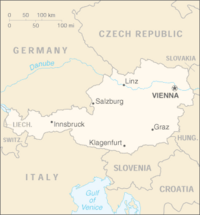Welcome to the Virtual Education Wiki ~ Open Education Wiki
Austria
by authorname authorsurname
Experts situated in Country
Country in a nutshell
Austria (German: Österreich), officially the Republic of Austria (German: Republik Österreich), is a landlocked country in Central Europe. It borders both Germany and the Czech Republic to the north, Slovakia and Hungary to the east, Slovenia and Italy to the south, and Switzerland and Liechtenstein to the west. The capital is the city of Vienna on the Danube River.
The origins of modern Austria date back to the ninth century, when the territory of Upper and Lower Austria became increasingly populated. The name "Ostarrichi" is first documented in an official document from 996. Since then this word has developed into the Österreich.
Austria is a parliamentary representative democracy comprising nine federal states and is one of six European countries that have declared permanent neutrality and one of the few countries that includes the concept of everlasting neutrality in its constitution. Austria has been a member of the United Nations since 1955 and joined the European Union in 1995.
Education in Country
The Republic of Austria has a free and public school system, and nine years of education are mandatory. Schools offer a series of vocational-technical and university preparatory tracks involving one to four additional years of education beyond the minimum mandatory level. The legal basis for primary and secondary education in Austria is the School Act of 1962. The federal Ministry of Education is responsible for funding and supervising primary, secondary, and, since 2000, also tertiary education. Primary and secondary education is administered on the state level by the authorities of the respective states.
Federal legislation played a prominent role in the education system, and laws dealing with education effectively have a de facto constitutional status because, like Austrian constitutional law, they can only be passed or amended by a two-thirds majority in parliament.
Private schools
Private schools that provide primary and secondary education and some teacher training are run mainly, but by no means exclusively, by the Roman Catholic Church and account for approximately 10% of the 6,800 schools and 120,000 teachers. Roman Catholic schools have a reputation for more discipline and rigor than public institutions, and some are considered elite institutions. Because there is no tradition of private university education in Austria, the state has a virtual monopoly on higher education. This has been changing slowly in recent years as private universities become more commonplace.
Matura
The official term for Matura in Austria is Reifeprüfung. The document received after the successful completion of the written and oral exams is called Maturazeugnis.
In the Gymnasium (AHS = Allgemeinbildende Höhere Schule), which, as opposed to vocational schools, focuses on general education, the Matura consists of 3–4 written exams (referred to as Klausurarbeiten, 4–5 hours each) to be taken on consecutive mornings (usually in May) and 3–4 oral exams to be taken on the same half-day about a month later (usually in June). All examinations are held at the school which the candidate last attended. Candidates have the option to write a scholarly paper (called Fachbereichsarbeit) to be submitted at the beginning of the February preceding the final exams, which, if accepted, reduces the number of written exams by one. This paper also needs to be defended in an oral exam.
The grading system is the one universally used in Austrian schools: 1 (sehr gut) is excellent; 2 (gut) is good; 3 (befriedigend) is satisfactory; 4 (genügend) is sufficient and 5 (nicht genügend) means that you have failed. In addition, a candidate’s Maturazeugnis contains a formalized overall assessment: "mit ausgezeichnetem Erfolg bestanden" (pass with distinction: an average of 1.5 or better, no grade below 3), "mit gutem Erfolg bestanden" (pass with merit: an average of 2.0 or better, no grade below 3), "bestanden" (pass: no grade below 4); and nicht bestanden (fail: at least one grade 5). Candidates who have failed may re-take their exams in September/October or February/March of the following school year.
Compulsory subjects for the written finals are German and Mathematics, as well as a foreign language (usually English, French, Spanish, Latin or sometimes Ancient Greek).
The most striking aspect of the Austrian Matura is that it is a decentralized affair. There are no external examiners: Candidates are set tasks both for their written and oral finals by their own (former) teachers. Formally, however, there is an examination board consisting of a candidate’s teachers/examiners, the headmaster/headmistress and a Vorsitzende(r) (head), usually a high-ranking school official or the head of another school. All oral exams are public, but attendance by anyone other than a candidate’s former schoolmates is not encouraged, and indeed rare.
It is, of course, possible for Austrians of all age groups to take the Matura. Adults from their twenties on are usually tutored at private institutions of adult education before taking their final tests, held separately before a regional examination board.
Criticism of the Austrian Matura has been persistent. In particular, it has been argued that the current system encourages rote learning (see also education reform), hinders candidates’ creativity and obscures the fact that the body of knowledge is constantly changing. Various forms of alternative assessment have been proposed, most notably the portfolio as well as teamwork and peer review also in exam situations.
In fiction, Friedrich Torberg’s novel Der Schüler Gerber (1930) about a Matura candidate driven to suicide on the day of his oral exams by his cruel mathematics teacher has become a classic.

